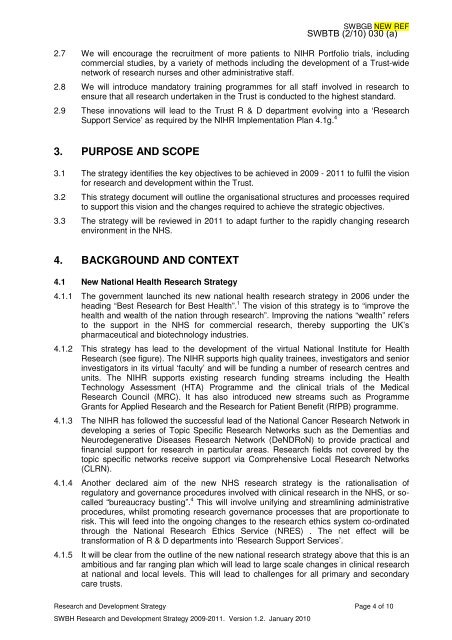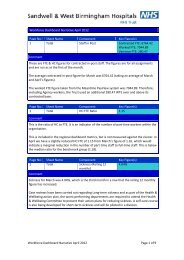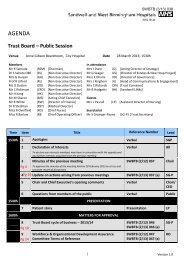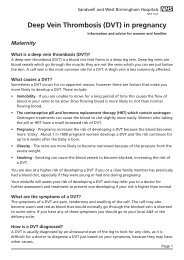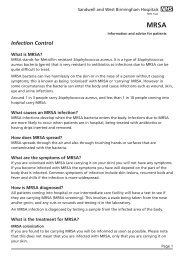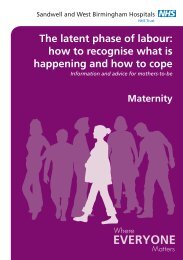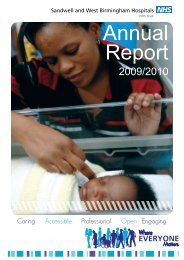Trust Board Febuary 2010 - Sandwell & West Birmingham Hospitals
Trust Board Febuary 2010 - Sandwell & West Birmingham Hospitals
Trust Board Febuary 2010 - Sandwell & West Birmingham Hospitals
Create successful ePaper yourself
Turn your PDF publications into a flip-book with our unique Google optimized e-Paper software.
SWBGB NEW REF<br />
SWBTB (2/10) 030 (a)<br />
2.7 We will encourage the recruitment of more patients to NIHR Portfolio trials, including<br />
commercial studies, by a variety of methods including the development of a <strong>Trust</strong>-wide<br />
network of research nurses and other administrative staff.<br />
2.8 We will introduce mandatory training programmes for all staff involved in research to<br />
ensure that all research undertaken in the <strong>Trust</strong> is conducted to the highest standard.<br />
2.9 These innovations will lead to the <strong>Trust</strong> R & D department evolving into a ‘Research<br />
Support Service’ as required by the NIHR Implementation Plan 4.1g. 4<br />
3. PURPOSE AND SCOPE<br />
3.1 The strategy identifies the key objectives to be achieved in 2009 - 2011 to fulfil the vision<br />
for research and development within the <strong>Trust</strong>.<br />
3.2 This strategy document will outline the organisational structures and processes required<br />
to support this vision and the changes required to achieve the strategic objectives.<br />
3.3 The strategy will be reviewed in 2011 to adapt further to the rapidly changing research<br />
environment in the NHS.<br />
4. BACKGROUND AND CONTEXT<br />
4.1 New National Health Research Strategy<br />
4.1.1 The government launched its new national health research strategy in 2006 under the<br />
heading “Best Research for Best Health”. 1 The vision of this strategy is to “improve the<br />
health and wealth of the nation through research”. Improving the nations “wealth” refers<br />
to the support in the NHS for commercial research, thereby supporting the UK’s<br />
pharmaceutical and biotechnology industries.<br />
4.1.2 This strategy has lead to the development of the virtual National Institute for Health<br />
Research (see figure). The NIHR supports high quality trainees, investigators and senior<br />
investigators in its virtual ‘faculty’ and will be funding a number of research centres and<br />
units. The NIHR supports existing research funding streams including the Health<br />
Technology Assessment (HTA) Programme and the clinical trials of the Medical<br />
Research Council (MRC). It has also introduced new streams such as Programme<br />
Grants for Applied Research and the Research for Patient Benefit (RfPB) programme.<br />
4.1.3 The NIHR has followed the successful lead of the National Cancer Research Network in<br />
developing a series of Topic Specific Research Networks such as the Dementias and<br />
Neurodegenerative Diseases Research Network (DeNDRoN) to provide practical and<br />
financial support for research in particular areas. Research fields not covered by the<br />
topic specific networks receive support via Comprehensive Local Research Networks<br />
(CLRN).<br />
4.1.4 Another declared aim of the new NHS research strategy is the rationalisation of<br />
regulatory and governance procedures involved with clinical research in the NHS, or socalled<br />
“bureaucracy busting”. 4 This will involve unifying and streamlining administrative<br />
procedures, whilst promoting research governance processes that are proportionate to<br />
risk. This will feed into the ongoing changes to the research ethics system co-ordinated<br />
through the National Research Ethics Service (NRES) . The net effect will be<br />
transformation of R & D departments into ‘Research Support Services’.<br />
4.1.5 It will be clear from the outline of the new national research strategy above that this is an<br />
ambitious and far ranging plan which will lead to large scale changes in clinical research<br />
at national and local levels. This will lead to challenges for all primary and secondary<br />
care trusts.<br />
Research and Development Strategy Page 4 of 10<br />
SWBH Research and Development Strategy 2009-2011. Version 1.2. January <strong>2010</strong>


